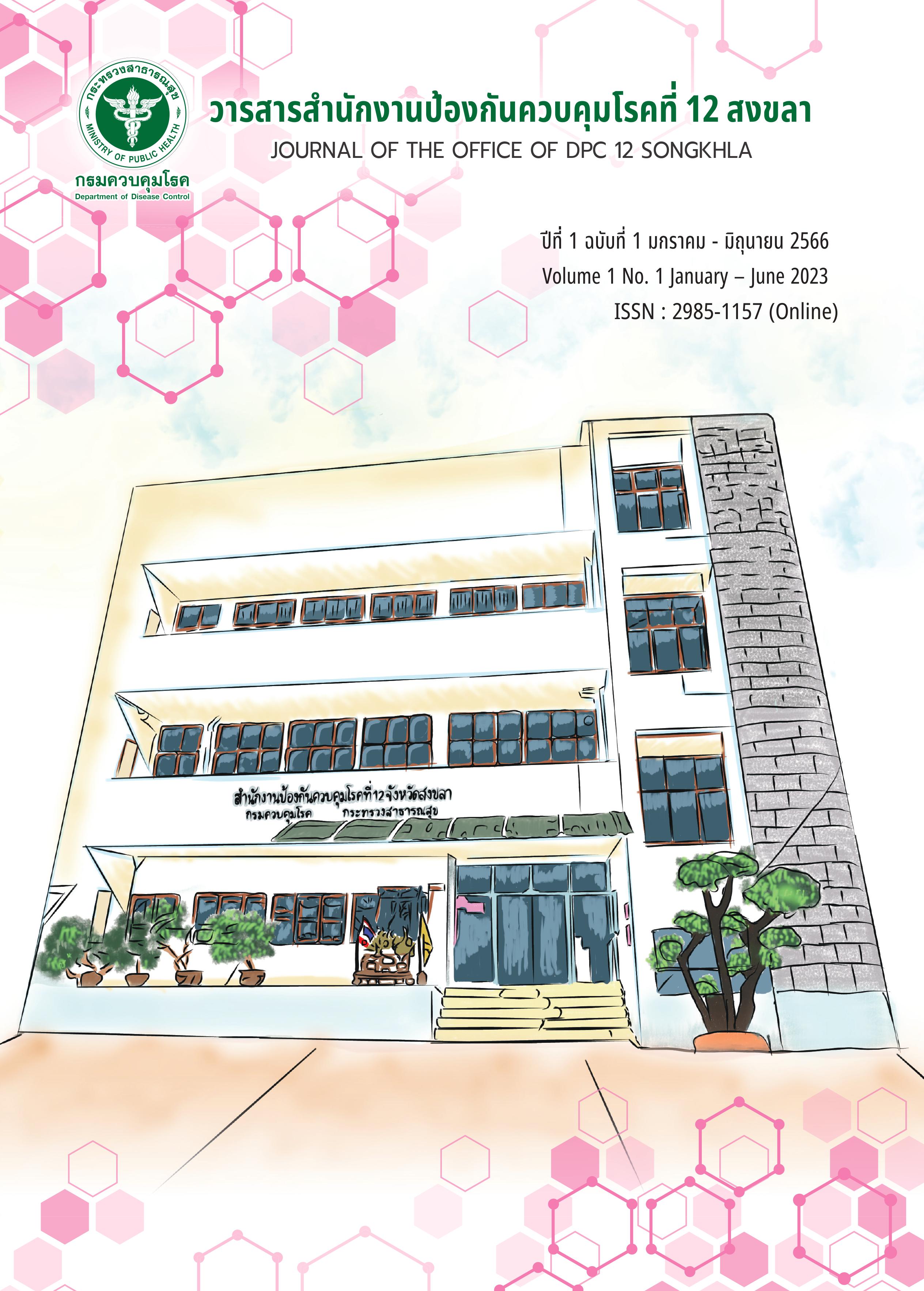ประสิทธิศักย์ไส้เดือนฝอย (Steinernema carpocapsae) สูตรผงละลายน้ำในการควบคุมแมลงวันบ้าน
คำสำคัญ:
แมลงวันบ้าน, ไส้เดือนฝอย, อัตราการตายบทคัดย่อ
แมลงวันบ้าน (Musca domestica L.) เป็นพาหะในการก่อโรคต่าง ๆ ในมนุษย์ เช่น โรคบิด ท้องร่วง และอาหารเป็นพิษ การศึกษาเพื่อควบคุมประชากรของแมลงวันบ้านจึงมีความจำเป็นอย่างยิ่ง ดังนั้นวัตถุประสงค์ของการวิจัยครั้งนี้ คือ ศึกษาประสิทธิศักย์ไส้เดือนฝอย (Steinernema carpocapsae) สูตรผงละลายน้ำในการควบคุมแมลงวันบ้าน ในขั้นตอนการทดลอง จะใช้แมลงวันบ้านตัวอ่อนระยะที่ 1-2 ที่เลี้ยงในห้องปฏิบัติการมาทำการทดสอบ โดยแต่ละชุดการทดสอบ จะทดสอบ 3 ซ้ำ ต่อ 1 ความเข้มข้น และ 1 ปริมาณพ่นทดสอบ จากนั้นจึงบันทึกผลอัตราการตายของแมลงวันบ้านที่เวลา 24, 48, 72 ชั่วโมงหลังจากการพ่น และนําข้อมูลที่ได้มาวิเคราะห์ ซึ่งผลการวิจัยพบว่า หลังจากพ่นไส้เดือนฝอยสูตรผงละลายน้ำความเข้มข้นมาตรฐาน 75 กรัม +150% ต่อน้ำ 20 ลิตร เป็นเวลา 72 ชั่วโมง แมลงวันบ้านมีอัตราการตายมากกว่า 90% และหลังจากพ่นไส้เดือนฝอยสูตรผงละลายน้ำความเข้มข้นมาตรฐาน 75 กรัม +200% ต่อน้ำ 20 ลิตร เป็นเวลา 24-48 ชั่วโมง แมลงวันบ้านมีอัตราการตายมากกว่า 95% จากผลการทดลองแสดงให้เห็นว่าไส้เดือนฝอยสูตรผงละลายน้ำมีคุณสมบัติและประสิทธิศักย์ในการควบคุมแมลงวันบ้าน และสามารถประยุกต์ใช้ในเชิงพื้นที่ต่อไปได้
เอกสารอ้างอิง
Hewitt CG. The structure, development, and bionomics of the house-fly, Musca domestica, Linn. Part I - The anatomy of the fly. J Cell Sci. 1907;2(203):395–448.
Abbas MN. House fly (Musca domestica), a challenging pest; biology, management and control strategies. Elixir Entomol [Internet]. 2013;64 (January 2013):19333. Available from:https://www.researchgate.net/publication/260285055
Iqbal W, Faheem MM, Kaleem SM, Iqra A, Iram N, Rashda A. Role of housefly (Musca domestica, Diptera; Muscidae) as a disease vector; a review. J Entomol Zool Stud. 2014;2(2):159–63.
Singh R. The Stages in Life Cycle of Housefly. Entomology , Ornithology & Herpetology : Current Research [Internet]. 2021 [cited 2023 Jan 18];10(9). Available from: https://www.longdom.org/open-access/the-stages-in-life-cycle-of-housefly-88100.html
Karami M, Pournajaf A, Rajabnia R, Omran SM, Heidarpour A, Alipour J, et al. Isolation of important cultivable bacteria from the moth flies (Clogmia albipunctata) as a mechanical vector in Babol hospitals, north of Iran. Allied J Med Res. 2020;4(1):40–3.
Hadi A. A study of prevalence of some parasites and protozoa from Musca domestica in Baghdad. Al-Anbar J Vet Sci. 2011;4(2):88–92.
Park R, Dzialo MC, Spaepen S, Nsabimana D, Gielens K, Devriese H, et al. Microbial communities of the house fly Musca domestica vary with geographical location and habitat. Microbiome. 2019;7(1):1–12.
Issa R. Musca domestica acts as transport vector hosts. Bull Natl Res Cent [Internet]. 2019 [cited 2023 Jan 21];43(1). Available from: https://bnrc.springeropen.com/articles/10.1186/s42269-019-0111-0
Solà-Ginés M, González-López JJ, Cameron-Veas K, Piedra-Carrasco N, Cerdà-Cuéllar M, Migura-Garcia L. Houseflies (Musca domestica) as vectors for extended-spectrum β-lactamase-producing Escherichia coli on Spanish broiler farms. Appl Environ Microbiol. 2015;81(11):3604–11.
Viteri DM, Linares AM, Flores L. Use of the Entomopathogenic Nematode Steinernema carpocapsae in Combination with Low-Toxicity Insecticides to Control Fall Armyworm (Lepidoptera: Noctuidae) Larvae. Florida Entomol. 2018;101(2):327–9.
Wong C, Oliveira-Hofman C, Blaauw BR, Chavez D, Jagdale G, Mizell RF, et al. Using the Nematode, Steinernema carpocapsae, to Control Peachtree Borer (Synanthedon exitiosa): Optimization of Application Rates and Secondary Benefits in Control of Root-Feeding Weevils. Agronomy. 2022 [cited 2023 March 8];12(11). Available from: https://www.mdpi.com/2073-4395/12/11/2689
GÖZEL U, GÜNEŞ Ç. Effect of entomopathogenic nematode species on the corn stalk borer (Sesamia cretica Led . Lepidoptera : Noctuidae at cretica Led . Lepidoptera : Noctuidae) üzerindeki etkinli ğ i Özet. Türk entomol derg. 2013;37(1):65–72.
Balasubramanian N, Toubarro D, SimÕes N. Biochemical study and in vitro insect immune suppression by a trypsin-like secreted protease from the nematode Steinernema carpocapsae. Parasite Immunol. 2010;32(3):165–75.
Labaude S, Griffin CT. Transmission success of entomopathogenic nematodes used in pest control. Insects [Internet]. 2018 [cited 2023 March 15];9(2). Available from: https://pubmed.ncbi.nlm.nih.gov/29925806/
Han R, Ehlers R-U. Pathogenicity, Development, and Reproduction of Heterorhabditis bacteriophora and Steinernema carpocapsae under Axenic in Vivo Conditions. J Invertebr Pathol [Internet]. 2000 [cited 2023 March 15];75(1):55–8. Available from: https://www.sciencedirect.com/science/article/pii/S0022201199949005
Hao Y-J, Montiel R, Abubucker S, Mitreva M, Simões N. Transcripts analysis of the entomopathogenic nematode Steinernema carpocapsae induced in vitro with insect haemolymph. Mol Biochem Parasitol [Internet]. 2010 [cited 2023 March 16];169(2):79–86. Available from: https://www.sciencedirect.com/science/article/pii/S0166685109002424
Abbott WS. A Method of Computing the Effectiveness of an Insecticide, Journal of Economic Entomology.1925;18(2): 265–7.
ดาวน์โหลด
เผยแพร่แล้ว
รูปแบบการอ้างอิง
ฉบับ
ประเภทบทความ
สัญญาอนุญาต
ลิขสิทธิ์ (c) 2023 วารสารสำนักงานป้องกันควบคุมโรคที่ 12 สงขลา

อนุญาตภายใต้เงื่อนไข Creative Commons Attribution-NonCommercial-NoDerivatives 4.0 International License.
วารสาร TCI อยู่ภายใต้การอนุญาต Creative Commons Attribution-NonCommercial-NoDerivatives 4.0 International (CC BY-NC-ND 4.0) เว้นแต่จะระบุไว้เป็นอย่างอื่น โปรดอ่านหน้านโยบายของเราสำหรับข้อมูลเพิ่มเติมเกี่ยวกับการเข้าถึงแบบเปิดลิขสิทธิ์ และการอนุญาต


